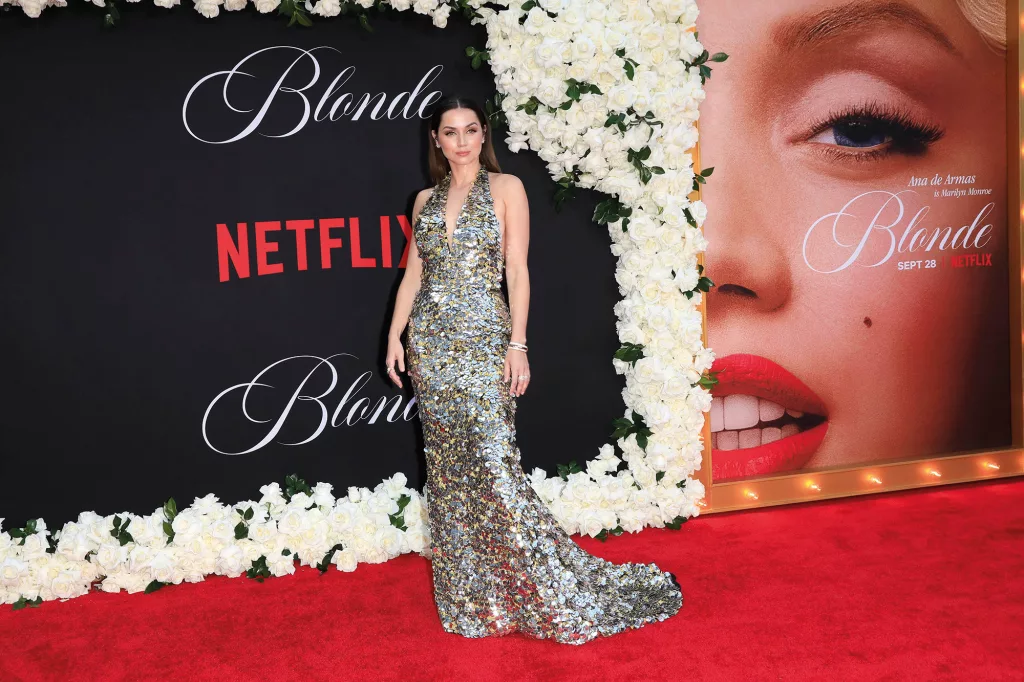Film Review – Blonde: Is Marilyn Biopic a Bombshell … or a Bust?
“Monroe is more than a sex symbol in new film”, one headlined review of Blonde declares. That must be why actress Ana de Armas spends half of the movie wearing no clothes.

Ana De Armas at the Blonde Premiere
Director Andrew Dominik is so passionate about teaching us that Marilyn Monroe was more than a pin-up girl that whether she is having a mental breakdown, being physically abused or raped, it is imperative we are able to see her breasts at all times.
Sometimes it feels as if she doesn’t even exist outside of the sphere of sex. It’s unclear whether Dominik believes we should be disgusted or titillated by these scenes. It is entirely possible to effectively depict sexual violence and abuse without graphic detail, or letting the camera linger too long.
In Blonde, the victimisation of Monroe is relentless to the point it becomes almost unaffecting. Dominik thinks she was dehumanised by Hollywood — but he never attempts to humanise her. More than just a victim of circumstance, she becomes an animatronic doll with no agency or personality.
It makes sense, then, that Dominik has said the film is not about Monroe’s life, but her slow march towards death. It’s perhaps meant to parallel the narrative of his 2007 film The Assassination of Jesse James by the Coward Robert Ford. What separates them is that Blonde makes no real attempt to understand its subject. Whether it is laziness, misogyny or disdain, the result is a poorly executed idea that smacks of torture porn.
Even if you choose to dismiss this as woke hysteria, Blonde is superficial and boring. Dominik has a unique visual style that borders on the quaint, despite upsetting subject matter. The Assassination of Jesse James is a striking feat of cinema. In Blonde, Dominik suffers the fate of many directors who achieve enough commercial success to surround themselves with yes-men. His reliance on unique visual effects is more garish than interesting, and I doubt in the way he intended. The viewer is caught wondering whether the crew was constrained by the sort of software teenagers used for taking Facebook selfies circa 2010.
Even the elements I thought I would enjoy, such as a soundtrack by Nick Cave and Warren Ellis, feel derivative and out-of-place. If the film had been made by a student, it might indicate promise; coming from an acclaimed director, it is a disappointment.
Blonde is the work of an artist who does not trust his audience. Dominik believes the people who don’t like his art are simply too stupid to understand. He’s so worried we won’t “get it” that all subtlety is lost over three hours of having the nail hammered into our heads. President John F Kennedy is depicted watching fireworks on TV as he orgasms, a photograph of Clark Gable becomes animated and talks to a young Marilyn, later she stargazes on a beach and remarks “look at them up there shining so brightly and yet each one is so very much alone”.
“Blonde is the work of an artist who does not trust his audience. Dominik believes the people who don’t like his art are simply too stupid to understand.”
The idea that Marilyn Monroe was a helpless victim of the Hollywood cabal has been overdone, and Dominik offers nothing new here. The biggest failure of Blonde is in believing its theory is a radical one. His source material is equally rote, but at least attempts to portray Marilyn Monroe as a human being, someone who had happy memories, a serious interest in literature and dedication to her craft. Although Joyce Carol Oates’ 2000 novel of the same name would eventually be nominated for a Pulitzer Prize, it was not without its detractors.
Internet misinformation is recycled every time there is renewed interest in Marilyn’s life. In a book review after the publication of Blonde in 2000, a New York Times article confidently informs us that Monroe had 12 abortions, and that these may have been the cause of her difficulty to conceive later in life. It is a remarkable assertion which offers no definitive source, and there is no historical evidence this had any basis in fact. To make a judgment on whether Monroe terminated any of her pregnancies is pointless. It serves to play into anti-choice debate. Oates and Dominik heavily rely on such imagery that the claim that Blonde is a feminist film is hard to swallow.
From the depiction of abortion as a forced, painful, traumatising medical procedure cumulates in the use of an animated foetus that asks Monroe: “You won’t hurt me this time, will you?”. The message is so damaging that even Planned Parenthood released a statement condemning it.
Despite some questionable choices, Oates clearly has a lot of interest in Monroe — something Dominik seems to lack. In one interview, he labels cinematic work a “whole lot of movies that nobody really watches”. Talking about what inspired her to write Blonde, Oates said: “I felt an immediate sense of something like recognition; this young, hopefully smiling girl, so very American, reminded me powerfully of girls of my childhood, some of them from broken homes.” There’s something to be said for her othering of girls from broken homes, but compared to the low bar of Dominik’s misogyny, Oates comes across as sympathetic.
When it comes to Marilyn Monroe, sympathy is not enough. She did have friends, and one of them, photographer Sam Shaw, once said: “Everybody knows about her insecurities, but not everybody knows what fun she was, that she never complained about the ordinary things of life, that she never had a bad word to say about anyone, and that she had a wonderful, spontaneous sense of humour.”
Watching Blonde, I couldn’t help thinking about Truman Capote’s essay about Monroe, entitled A Beautiful Child. Published a decade after her death, it tried to capture the bubbly side of her. She swears like a sailor. She describes the Queen of England using words that I shan’t repeat, and they would never make it to print. Remarking on the tabloid journalists who ran gossip columns about her, she asks Capote “What did I ever do to those hags?”. I wonder how this woman with a dirty mouth and dry sense of humour has been replaced by one seemingly made of glass. A fragile Ana De Armas, bare-chested, constantly quivering, forever on the precipice of tears.
What Dominik fails to understand in Blonde is that there is no slow march towards death. People’s lives are not neat stories. Even those suffering from mental illness can have happy days, and that tragic drug overdose could truly have been an accident.
The problem with Blonde is it does exactly what it accuses everyone else of doing. It has been described as a “cultural artefact of the #MeToo era” — but it denigrates the women who paved the way for the movement. Monroe was one of those women.
By Kitty Wenham
You may have an interest in also reading…
The World: Sail Into a Life of Luxury and Adventure
Imagine waking to a view of the Sydney Opera House, and a few weeks later taking breakfast on the Mediterranean
David Hume’s Philosophy, Controversy, Superstition, Atheism — and Lucky Toes
The Scots philosopher’s sometimes divisive words gave him prominence in life, as in death. It’s ironic that a statue of
Forging Fitness, Dissolving Boundaries: Give CrossFit a Try Sometime Soon
Unlocking the transformative power of functional fitness can be fun as well as beneficial for wellbeing. CrossFit has become an



















































































